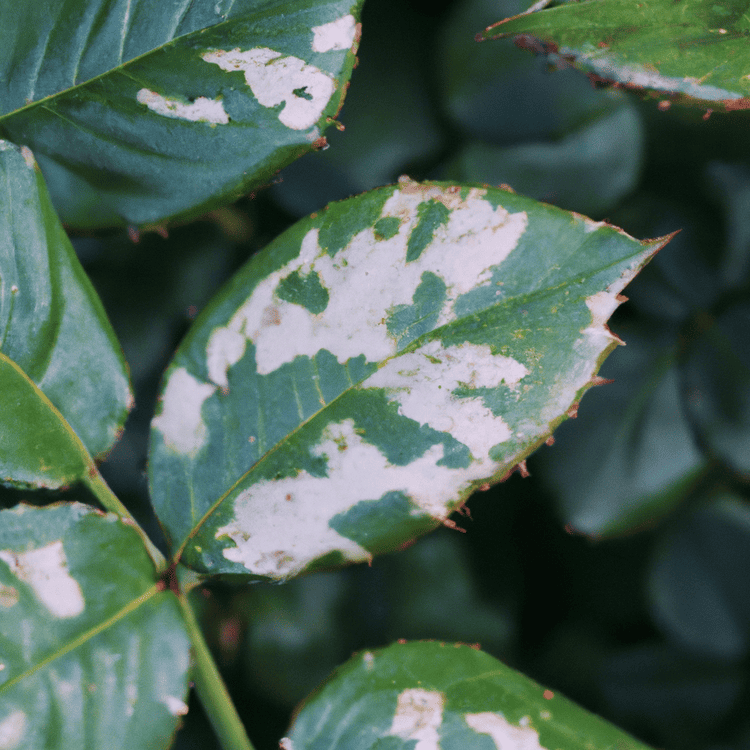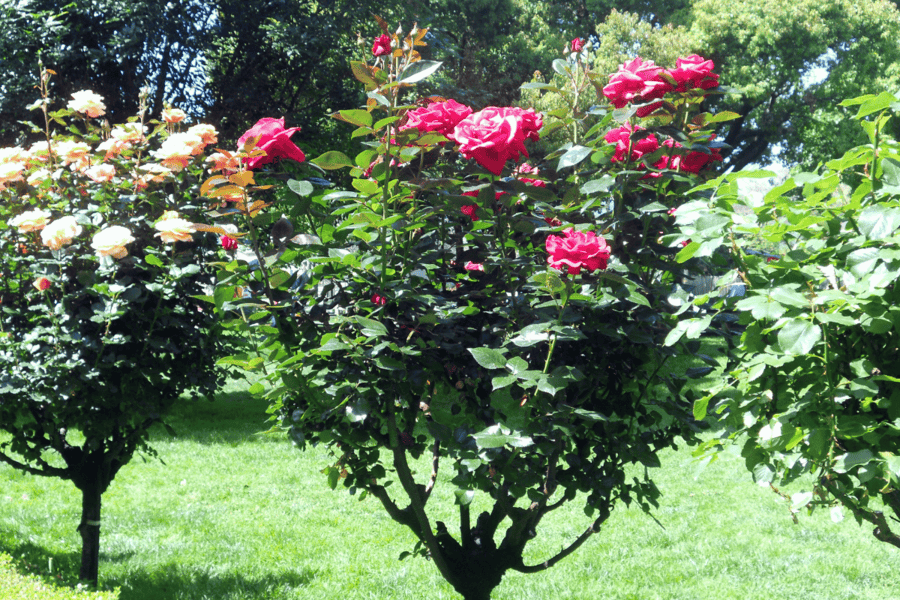White spots on rose leaves can be a sign of various issues that can threaten the health and beauty of your plants. These spots can be caused by a fungal disease called powdery mildew, which can spread quickly and damage the entire plant. Other causes of white spots on rose leaves include aphids, anthracnose, and the mosaic virus.
Powdery mildew is a common fungal disease that affects many plants, including roses. It appears as a white powdery coating on the leaves, stems, and buds of the plant. If left untreated, powdery mildew can weaken the plant and cause it to stop producing flowers. Other signs of powdery mildew include curled and distorted leaves.
Aphids, anthracnose, and the mosaic virus can also cause white spots on rose leaves. Aphids are small insects that feed on the sap of the plant, leaving behind a sticky residue that can attract other pests. Anthracnose is a fungal disease that causes brown spots on the leaves and stems of the plant. The mosaic virus causes mottled yellow and green spots on the leaves, which can eventually lead to stunted growth and reduced flower production.
Table of Contents
Causes of White Spots on Rose Leaves
White spots on rose leaves can be caused by various factors, including fungal diseases, insect infestations, and viruses. Proper care and maintenance of rose bushes can help prevent the occurrence of white spots on leaves.
Fungal Diseases
Powdery mildew, black spot, downy mildew, cercospora leaf spot, and rose rosette are fungal diseases that can cause white spots on rose leaves. These diseases thrive in moist environments and can spread through fungal spores. Proper spacing, air circulation, and sanitation practices can help prevent the spread of fungal diseases. Fungicides can also be used to treat infected plants.
Insect Infestation
Insects such as aphids, leafhoppers, mealybugs, sawflies, and spider mites can also cause white spots on rose leaves. Insecticides can be used to control insect infestations. Pruning infected canes and using disease-resistant roses can also help prevent insect infestations.
Mosaic Virus
Rose mosaic disease is caused by a virus and can cause white spots on rose leaves. Infected plants should be pruned and removed to prevent the spread of the virus. Disease-resistant roses can also help prevent the occurrence of the virus.
Anthracnose
Anthracnose is a fungal disease that can cause white spots on rose leaves. Fungicides can be used to treat infected plants. Proper spacing, air circulation, and sanitation practices can also help prevent the spread of anthracnose.
Bacteria and Viruses
Bacteria and plant viruses can also cause white spots on rose leaves. Sanitation practices can help prevent the spread of these diseases. Infected plants should be pruned and removed to prevent the spread of the disease.
Pests
Insects such as aphids, leafhoppers, mealybugs, sawflies, and spider mites can also cause white spots on rose leaves. Insecticides can be used to control insect infestations. Pruning infected canes and using disease-resistant roses can also help prevent insect infestations.
Proper care and maintenance of rose bushes, including regular watering, fertilization, and pruning, can help prevent the occurrence of white spots on leaves. It is also important to plant roses in a location with full sun exposure and good air circulation.

Symptoms of White Spots on Rose Leaves
White spots on rose leaves are a common occurrence and can cause alarm for gardeners. These white spots are usually caused by a fungal disease known as powdery mildew. The disease can affect all parts of the rose plant, including leaves, stems, flower stalks, and even petals. Here are some symptoms of white spots on rose leaves:
- White, powdery spots on the upper surface of the leaves
- Yellow or brown spots on the leaves
- Curling or twisting of leaves
- Premature leaf drop
- Stunted growth of the plant
- Deformed or distorted flowers
The white spots on rose leaves are caused by the fungus Podosphaera pannosa, which produces spores that spread like a disease between the plants. The disease is most common during the summer months when the weather is warm and humid.
Powdery mildew can weaken the rose plants and make them more susceptible to other diseases and pests. Therefore, it is important to identify and treat the disease as soon as possible. If you notice any of the symptoms mentioned above, it is important to take action to prevent the spread of the disease. You can start by removing the infected leaves and disposing of them properly. You can also prune the plant to increase air circulation and reduce humidity around the plant.
There are also several fungicides available that can help control powdery mildew. These fungicides should be used as directed and applied regularly to prevent the disease from spreading. Overall, it is important to keep a close eye on your rose plants and take action at the first sign of white spots on the leaves. With proper care and treatment, you can keep your roses healthy and beautiful.
Treatment and Prevention of White Spots on Rose Leaves
Chemical Treatments
Chemical treatments can be effective in treating white spots on rose leaves. Fungicides, insecticides, and horticultural oils can be used to control fungal diseases and pests. Neem oil, which is derived from the neem tree, is a natural insecticide that can be used to control pests. Dish soap and baking soda solution can also be used to clean off the white spots.
It is important to follow the instructions on the label when applying chemical treatments to prevent damage to the plant. Overuse of chemical treatments can lead to the development of resistance in pests and diseases.
Natural Treatments
Natural treatments can also be effective in treating white spots on rose leaves. Pruning the plant to improve air circulation and spacing the plants out can help prevent the development of fungal diseases. Composting and fertilizing the soil can also improve the overall health of the plant and make it more resistant to diseases.
Watering the plant at the base and avoiding getting water on the leaves can also help prevent the development of fungal diseases. Sanitation and clean-up of fallen leaves and debris can also help prevent the spread of diseases.
Prevention
Prevention is key in controlling white spots on rose leaves. Choosing disease-resistant roses and planting them in a location with adequate sunlight and air circulation can help prevent the development of fungal diseases. Regular maintenance, including pruning and fertilizing, can also improve the overall health of the plant and make it more resistant to diseases.
It is also important to practice good sanitation and clean-up of fallen leaves and debris to prevent the spread of diseases. Spacing the plants out and avoiding overcrowding can also improve air circulation and prevent the development of fungal diseases.
In summary, treating and preventing white spots on rose leaves can be achieved through a combination of chemical and natural treatments, as well as regular maintenance and good sanitation practices. By following these guidelines, gardeners can enjoy healthy and beautiful roses for years to come.
Frequently Asked Questions
How Do You Treat Powdery Mildew on Roses?
To treat powdery mildew on roses, it is recommended to use a fungicide. There are several fungicides available in the market, and it is important to choose the one that is specifically formulated for roses. Follow the instructions on the label carefully, and apply the fungicide as directed. It is also important to remove any infected leaves or stems to prevent the spread of the disease.
What Are Some Home Remedies for Powdery Mildew on Roses?
Home remedies for powdery mildew on roses include using a solution of baking soda and water, or a mixture of milk and water. These solutions can be sprayed on the affected leaves and stems to control the disease. However, it is important to note that these remedies may not be as effective as commercial fungicides.
What Causes White Spots on Rose Bush Branches?
White spots on rose bush branches can be caused by several factors, including powdery mildew, aphids, anthracnose, and the mosaic virus. These diseases can cause white spots to appear on the leaves, stems, and even petals of the rose bush.
What Is the Best Way to Treat White Spots on Rose Buds?
The best way to treat white spots on rose buds is to remove the infected buds immediately. This will prevent the disease from spreading to other parts of the plant. It is also important to keep the plant healthy by providing it with adequate water, nutrients, and sunlight.
How Do You Get Rid of White Fungus on Rose Stems?
To get rid of white fungus on rose stems, it is recommended to use a fungicide. Remove any infected stems and leaves, and apply the fungicide as directed on the label. It is also important to keep the plant healthy by providing it with adequate water, nutrients, and sunlight.
What Are Some Effective Treatments for Rose Fungus?
Effective treatments for rose fungus include using a fungicide, pruning infected stems and leaves, and providing the plant with adequate water, nutrients, and sunlight. It is important to choose a fungicide that is specifically formulated for roses and to follow the instructions on the label carefully.
Last Updated on June 16, 2023 by Gustaf Johansson




